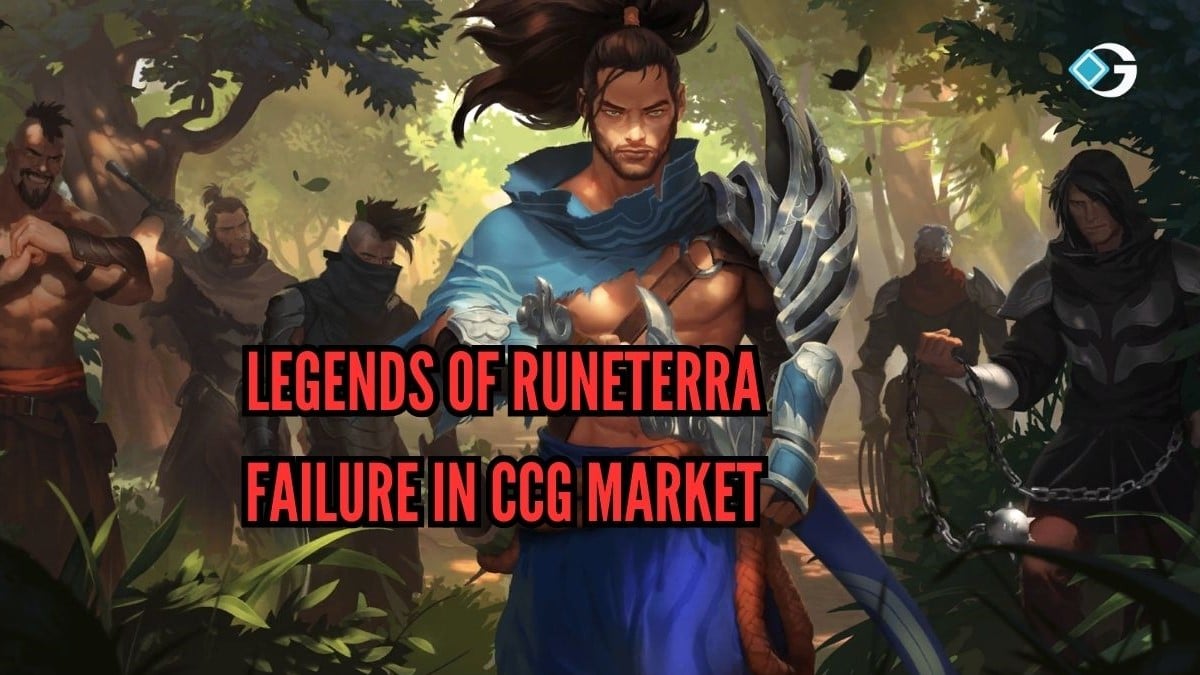Legends of Runeterra failed in the Collectible Card Games (CCG) market for both technical and strategic reasons.
Legends of Runeterra (LoR) is a card game from Riot Games. It shares the same universe as League of Legends. You can find all the champions and characters from the giant, unified world of Runeterra. When it comes to lore exploration, Legends of Runeterra is a gold mine. The gameplay aspect of it, emphasizing strategic deck building, is brilliant enough as well.
Compared to Hearthstone, with more than 50 million active monthly players, LoR has barely 10 million under its belt. This is a low number considering it’s being a part of the shared Lol universe, which should have attracted a much bigger population.
Legends of Runeterra blended gameplay concepts from other successful card games such as Magic: The Gathering, Gwent, etc. while also adding its own formula to it. Despite having a nuanced card game, it didn’t become nearly as successful as you would expect from it.
In this article, I will share my own 2 cents on this matter.
Read More: Legends of Runeterra Prime Gaming Loot Rewards In January 2024
Legends of Runeterra: Reasons for Failure in the CCG Market
- Saturated Market
The first and foremost reason for LoR failing to succeed in the CCG market is that the market itself is overly saturated. If you look at the market, there are 100s of card games there. Yu-Gi-Oh!, Magic The Gathering, Pokemon, etc are all big names that had already dominated the market.
Think about Riot’s most successful games. League of Legends, Valorant, and even TFT had massive success. LoL was sort of like the first MOBA game to get mainstream appeal, despite succeeding Dota.
VALORANT was released when Counter-Strike died, and the FPS market was saturated with battle royale games. VALORANT introduced a fresh breath of air to the tactical shooter market and due to its low-skill floor, it captured the market very quickly and is still rapidly growing.
For LoR, there was no factor working for it in that regard.
2. Complex Game Design
Usually, this would be considered a pro for a card game. The hardcore fans would love to select from a plethora of decks in different combinations. However, it also creates a high skill barrier for entry. Most of the popular card games are very straightforward. “Your turn, My turn” – LoR detracted from this philosophy and isolated a huge chunk of casual players.
The overabundance of regions in the game creates pain for card balancing and distribution. LoR also had issues with being repetitive, and decks being tied up to certain characters only. This added to the unintuitiveness as well.
On the other hand, Hearthstone, despite being a fairly simple and boring game (compared to LoR), attracts a wide audience. Because the card players are kind of inert when it comes to exploring other card games. Especially, since there is no reason to move and explore something with many more layers of nuances.
3. Marketing
Riot Games are really good marketers, that’s for sure. But for LoR, there’s practically no effort from the marketing team. Personally speaking, I have never seen any Ad that even remotely talks about LoR. On the other hand, I have read about Magic: The Gathering from countless of web-page ads on my Android phone.
Yu-Gi-Oh!, Pokemon, etc. card games get massive traction from their other industry products, such as Anime, other video games, etc. LoR has League of Legends by its side but even a lot of the LoL players haven’t heard of LoR.
4. Monetization
Riot maintains its Free-to-Play policy for LoR as well when it comes to providing the players with a competitive edge. You can be competitive in the game without being motivated to spend a single cent. Because Riot doesn’t want it. On the other hand, Hearthstone, for example, requires you to spend money to build a competitive deck. Then there’s Marvel Snap who implemented a soft progression cap.
LoR’s monetization is only relevant for getting Wildcards. But even if you play the game for free, all the essential cards will come to you at the right pace because the game wants you to give the freedom.
This is quite in contrast with Magic: The Gathering’s monetization system. To play non-standard game mode, use historic cards in ranked format or basic land arts – everything is blocked behind a paywall. Then there are booster packs, singles market, etc. that players actively spend money on.
Gwent has Kegs (containing random cards to improve Gwent decks), card skins, avatars, game boards, reward books, etc that can be purchased with money.
In these games, a player who spends money and a player who doesn’t will experience entirely different worlds in terms of progression and competitive deck building. But a LoR player will practically feel little to no difference in that regard. Yes, there’s monetization involved for skins, card backs, etc. cosmetics but they aren’t gameplay-related.
Even boards and guardians can be purchased through in-game coins. You can choose to buy coins with real money. But that’s an option only. You will never feel forced to.
Riot Games emphasizes a generous free-to-play experience by rewarding players with a steady stream of cards, in-game currency, and cosmetics through regular gameplay. Monetization is strictly optional.
Because of the above issues, especially the saturated market, a total lack of marketing efforts, and suboptimal monetization methods (considering the CCG market), LoR has failed to realize its goal.
Needless to mention, the free-to-play experience, added with high complexity game design axed its player base, to the point there aren’t enough players to even spend on the game. All these factors contributed to the massive failure of the game.








